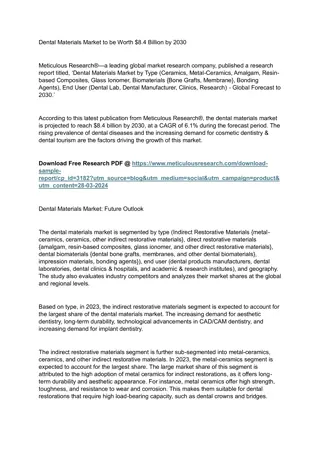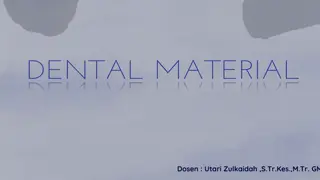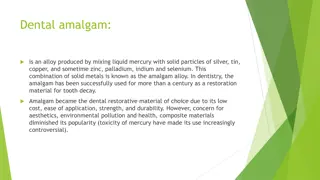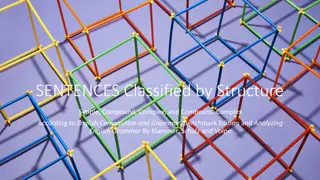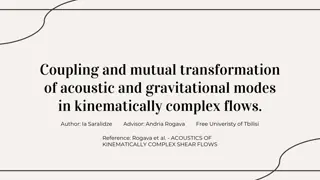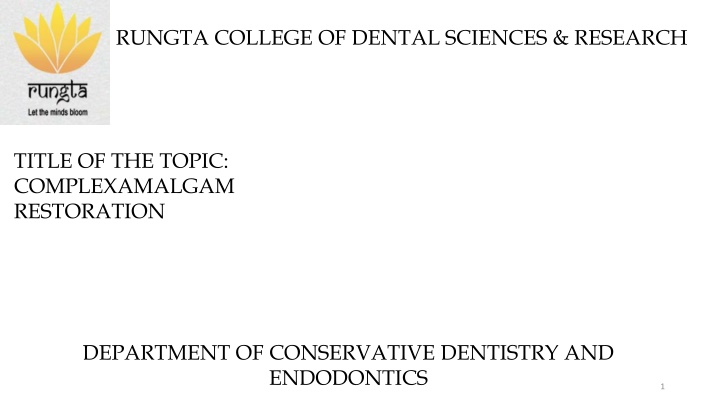
Complex Amalgam Restorations in Conservative Dentistry and Endodontics
This presentation focuses on the intricacies of complex amalgam restorations in the field of Conservative Dentistry and Endodontics. It covers topics like mechano-anatomical principles for pin placement, complications during pin placement, failure of pin-retained restorations, different types of amalgam foundations, restoration techniques, and more. The content delves into specific learning objectives and provides insights into addressing challenges such as pulpal penetration, lateral perforations, apical attachments, heat generation issues, and microleakage concerns.
Download Presentation

Please find below an Image/Link to download the presentation.
The content on the website is provided AS IS for your information and personal use only. It may not be sold, licensed, or shared on other websites without obtaining consent from the author. If you encounter any issues during the download, it is possible that the publisher has removed the file from their server.
You are allowed to download the files provided on this website for personal or commercial use, subject to the condition that they are used lawfully. All files are the property of their respective owners.
The content on the website is provided AS IS for your information and personal use only. It may not be sold, licensed, or shared on other websites without obtaining consent from the author.
E N D
Presentation Transcript
RUNGTA COLLEGE OF DENTAL SCIENCES & RESEARCH TITLE OF THE TOPIC: COMPLEXAMALGAM RESTORATION DEPARTMENT OF CONSERVATIVE DENTISTRY AND ENDODONTICS 1
Specific learning Objectives At the end of this presentation the learner is expected to know ; Core areas* Domain ** Category # FAILURE OF AMALGAM RESTORATION COGNITIVE MUST NOW EFFECT OF PIN ON PULP PSYCHOMOTOR NICE TO KNOW AMALGAM FOUNDATION AFFECTIVE DESIRE TO KNOW 2
Table of Content Mechano anatomical principles for pin placement Principles for pin placement. Complication during pin placement Failure of pin retained restorations Slot retained amalgam restorations Amalgam foundations Chamber retention Restorative technique Bonded amalgam Conclusion References
Pulpal penetration may occur at mesiofacial corner of maxillary & mandibular first molars Pulpal penetration treated as a pinpoint exposure Ca OH and prepare another hole If patient complains of pain after that endodontic treatment
Lateral Perforation: Occlusal to gingival attachment Pin cut-off flush with the tooth surface. Pin cut-off cast restoration extend gingivally.. Remove pin enlarge hole and restore with amalgam.
Apical to gingival attachment Surgically remove the bone after reflecting the tissue,enlarge pinhole, restored with amalgam Crown lengthening and cast restoration cover the perforation.
Heat generation: Rise in temperature subsequent to the use of twist drill may be related to cutting deep channels, high rotational speeds used during channel preparations, large sized twist drills and repeated insertion of pin drills into dentin. reduced by using 2 mm depth limiting drill and the smallest pin possible
Microleakage: The use of pins conceivably aggravates the leakage problem by producing fine cracks and craze lines that behaves as communication channels with the exterior and the pulp. Leakage with cemented pins occurs around its whole circumferance. Where as with friction locked and threaded pins occurs in semilunar pattern .
Microleakage can be almost eradicated under amalgam restorations by applying cavity varnish on the entire cavity surface including the pin channels. Pin channels prepared significantly inside the dentino enamel junction also reduce the possibility of cracks extending to the dentin defects or the external surface hence reducing microleakage. 7. Microcracks: Microcracks usually form subsequent to introduction of friction locked and threaded pins into dentin.
Failures of pin retained restoration: Failures of pin retained restoration: May occur in five areas: 1. Fracture of dentin: The solution is to reduce the area to a flat surface and re-drill a pinhole. 2. Separation of pin from dentin: Treatment includes re cementing if it is composite restoration performing the whole procedure again if restoration or it is amalgam
3. Pin fractures: Remove any remaining restorative material from the cavity preparation. Re-do the procedure and restoration again. 4. Separation of pin from restorative material: of failures. Formation of corrosion products at the interface is the most common cause for such type Treatment includes removal of any remaining restoratives material pins are checked for loosing and restoration done again. 5. Failure of restorative material : The most common cause for such type of failure is an improperly retained matrix. again. The treatment includes removing the remaining restorative material and tooth is restored
Effect of pins on Pulp: Pulp responds positively to the pin and accepts its presence with out any adverse effects . If the tooth is carious, symptomatic or a hermetic seal is not maintained under the restoration, the pulp may succumb to the injuries. The proximity of pin channels to the pulp tend to induce pulpal responses like destruction of odontoblastic nuclei, vascular dilation, and inflammatory cell infiltration.
Inflammatory reactions have been observed under all three types of pins i.e. cemented ,friction locked and threaded. The response under cemented pins is attributed to the type of cement used and its effect on pulp. Pulpal response under friction locked and threaded pins are probably because of the microcracks generated in communication with the pulp or disruption of the odontoblastic processes.
AMALGAPIN: - Introduced in 1980 by Shavell - Retention for amalgam is provided by 2-3mm deep holes placed in dentin by using round ended bur No. 1156, 1157, 1158 instead of placing pin - Amalgam is then condensed into holes and the remainder of restoration.
Advantages: 1.No microleakage 2. No stress in dentin. 3. No need of pins and pin system 4. Pulp irritation is avoided Disadvantages: More tooth structure is removed. Shear strength of amalgam pin is less.
Other complex amalgam preparation Other complex amalgam preparation SLOT RETAINED AMALGAM RESTORATIONS A slot is a retention groove in dentin whose length is in a horizontal plane. Circumferential slots. Outhwaite et al introduced the circumferential slot prepared with a no. 33 inverted cone bur segmental slots (short segments of circumferential slots) ----- cleats.
Indications When loss of vertical coronal height is approximately 2 to 4 mm, then use of slots, in horizontal areas where no vertical walls remain, In conjunction with pin retention or as an alternative to it. (Slot retention are used in preparations with vertical walls that allow retention locks to oppose one another. Pin retention is used more frequently in preparation with few or no vertical walls. ) In short clinical crowns and in cusps that have been reduced 2-3 mm for amalgam.
Disadvantages More tooth structure is removed Advantages Less likely to create microfracture in dentin or to perforate in to pulp more sensitive to displacement during matrix removal than are pin retained restorations Retention potential of pin and slots is similar
Slots are placed in the gingival loor of a preparation with a No. 330 bur. In general, slots should be about 1 mm wide and 1 mm deep, should be placed in the line-angle areas of the tooth, should be 2 to 4 mm in length 0.5 to 1 mm inside the DEJ. In general, one slot per missing axial line angle should be used. Increasing the width and depth of the slot does not increase the retentive strength of the amalgam restoration. Slot length depends on the extent of the tooth preparation continuous or segmented
AMALGAM FOUNDATIONS AMALGAM FOUNDATIONS A foundation is an initial restoration of a severely involved tooth. It will support the final restoration. Indications for amalgam foundations A tooth that is severely broken down and lacks the resistance and retention forms needed for an indirect restoration. It relies mainly on secondary preparation retention features (pins, slots, cones and proximal retention locks) and somewhat on bonding benefits. As a temporary control restoration for caries or for a tooth with questionable prognosis. Foundations are placed in preparation for a full crown especially in endodontically treated teeth.
Tooth preparation Tooth preparation The techniques followed depend on the type of retention that is selected, having in common the axial location of the retention. These include. Pin retention Severely broken down teeth with few or no vertical walls where an indirect restoration is indicated, may require a pin-retained foundation The pinholes must be located further from the external surface of the tooth More bending of the pins may be necessary to allow adequate axial reduction of the foundation without exposing the pins during the cast metal tooth preparation.
The location of the pinhole from the external surface of the tooth for foundations depends on o The occlusogingival location of the pin o The type of restoration to be placed ,a porcelain forced to metal or all-ceramic preparation requires more reduction than a fill gold crown. o The type of margins to be prepared Preparation with heavily chamfered margins at a normal occluso gingival location require pin (and slot) placement at a greater axial depth. Proximal retention locks should be used whenever possible. The length of the pins also must considered to permit adequate occlusal reduction without exposing the pins
Slot retention Slot retention Slots are placed in the gingival floor of a preparation with a No 33 bur. Foundation slots a with pins, are placed slightly more axial (father inside the DEJ)
Chamber retention Chamber retention For developing foundation is multi rooted endodontically treated teeth, an alternative technique has been described by Nayyar et al. recommended only when (1) dimension to the pulp chamber is adequate to provide retention and bulk of amalgam and (2) dentin thickness in the region of the pulp chamber is adequate to provide rigidity and strength to the tooth.
Kane et al demonstrated that extension into the root canal space 2 to 4 mm is recommended when the pulp chamber height is 2mm or less. After matrix application, amalgam is then thoroughly condensed into the pulp canals, the pulp chamber and the coronal portion of the tooth. Natural undercuts in the pulp chamber and the divergent canal provide necessary retention form
Resistance form is improved by gingival extension of crown structure 2mm beyond the foundation onto sound tooth structure. This extension should have a total taper of opposing walls of less than 100. If the pulp chamber height is less than 2 mm, the use of a prefabricated post, cast post and core, pins or slots should be considered following placement of the foundation, the tooth may be prepared for the crown or on lay and indirect restoration completed.
Restorative technique Restorative technique Use desensitizer or bonding system Dentin bonding systems are usually recommended for extensive preparations, particularly with deep excavations, capped cusps and in weak teeth. Application of Matrix: Matrices used are 1.Toffelemiere 2.Auto matrix 3.Copper band
Inserting the amalgam Inserting the amalgam A high copper alloy is strongly recommended for the complex amalgam restoration because of excellent clinical performance and high early compressive strength. Spherical alloys have a higher early strength than the admixed alloys, and spherical alloys can be condensed quicker with less pressure to ensure good adaptation around the pins. However, proximal contacts may be easier to achieve with admixed alloy because of their condensability and their extended working time
Resin bonded amalgam restoration An amalgam restoration that has been bonded to the existing tooth structure through the placement of a resin dentin bonding agent followed by a viscous resin(or glass ionomer) liner into which the fresh amalgam is condensed while the liner is still unset.
History History 1986 by Varga et al The first reports of experiments involving the use of adhesives under amalgam restorations were published .They assessed the bond between amalgam and human enamel as well as their effect on the marginal seal 1987, Shimizu et al studied use of an adhesive liner to reduce microleakage with or without glass ionomer base and fluoride treatment. 1988, Staninec and Holt measured tensile strength of amalgam to tooth structure as well as the microleakage at amalgam tissue interface. They reported that amalgam can adhere to acid treated enamel and dentin through a thin coat of Panavia resin.
1992 Eakle et al showed the effect of bonded amalgam restoration in relation to resistance of teeth to fracture. They reported that a tooth restored with bonded amalgam requires a significantly greater load to fracture than does a tooth restored with amalgam and no adhesive.
Amalgam bonding system Amalgam bonding system Used to seal underlying tooth structure and bond amalgam to enamel and dentin. Amalgam is strongly hydrophobic, whereas enamel and dentin are hydrophilic. Therefore the bonding system must be modified with wetting agent that has the capacity to wet both hydrophobic and hydrophilic surfaces.
4-methyloxy ethyl trimellitic anhydride (4-META)-based systems, ,10 MDP(10methacryloxy decyl dihydrogen phosphate) and bis GMA phosphonated ester are used frequently. This monomer molecule contains both hydrophobic and hydrophilic end. The HEMA acts as a vehicle which carries the tri-n-butyl borane catalyst and 4 META base into the dentin where oxygen and water supportably serves as co- catalyst for polymerization
Method of use and theory of amalgam Method of use and theory of amalgam bonding bonding After removal of carious lesion, proper isolation of the affected tooth is carried out using a rubber dam. The tooth is etched using 33-37% phosphoric acid. The acid is washed away by a stream of water. The preparation should then be briefly dried, resulting in moist and glistening dentin surface. If preparation is over dried, it may be rewetted with water or with HEMA and gluteraldehyde based desensitizer The primer should then be applied using technique described by the manufacturer.
After drying the primed surface ,there should be glossy in appearance. If it is not, primer should be reapplied until surface is glossy. Before mixing base and catalyst from the adhesive, the amalgam should be triturated and ready to be inserted into the preparation. Base and catalyst should be mixed, following manufacturers instructions. After resin is placed amalgam should be condensed into the cavity and carved.
With subsequent application of the adhesive the formation of a hybrid layer results and a micromechanical bond is formed to the dentin surface. The bond to the enamel is formed through the use of auto- polymerising resin. Bond strength for amalgam restoration 10MPa
This bonding mechanism actually may depend on type of amalgam used; for example, spherical amalgam alloy typically have higher bond strength than dispersed phase or admixed amalgam alloy. The bonding system used for amalgam bonding should be essentially self cure system. Some studies also suggest that use of dual cure bonding systems may be beneficial for bonding amalgam to dentin.
Bonding mechanism Bonding mechanism Bonding interface consists of both tooth,amalgam and in between them the intervening adhesive resin. The bond that develops between dentin and amalgam is essentially a micromechanical bond and no chemical bonding occurs In some system such as those containing 10MDP ,phosphate monomer can react with tin to provide some adhesion Dentin Interface micromechanical (formation off hybrid layer) Amalgam Interface micromechanical (interlock between viscous resin and fresh amalgam) Weak Links resin/amalgam interface
Indications of bonding Indications of bonding When remaining tooth structure after cavity preparation is weak,bonding reinforces resistance form of the restored tooth where sufficient thickness of amalgam can t be provided. Bonding provides auxiliary retention in deep bite cases where cervico occlusal dimension is less than normal. In extensively carious posterior teeth as cheaper substitute for cast metal and metal ceramic restoration As core for cast crown restoration
Advantages Advantages 1.Minimize or eliminate microleakage 2. Enhance traditional resistance and retention methods 3. Increase the fracture resistance of the restored tooth 4. Permit more conservative restorations 5. Decrease marginal breakdown and ditching 6. Reduced incidence off postoperative tooth sensitivity
Disadvantages Disadvantages Extra steps and expense(both time and materials) Technique sensitive and messy Adhesive may stick to matrix,instruments and adjacent tooth structure Carving more difficult Finishing usually requires rotary instrumentation After few years of use bond strength is reduced due to repeated thermocycling in the oral cavity.
TAKE HOME MESSAGE TAKE HOME MESSAGE Because of its history, the complex amalgam restorations may be the most frequently placed complex restoration. However due to the increasing benefits of composites, the many types of auxiliary retention forms available, and the variations of tooth preparations required for complex restorations, the operator should be familiar with all of these techniques, if he or she is to use these restorations on a regular basis.
QUESTIONS WHAT IS RESTORATIVE TECHNIQUE CHAMBER TECHNIQUE EFFECT OF PIN ON PULP
REFERENCES: 1. Sturdevant's Art and Science of Operative Dentistry - fourth Edition 2. Operative Dentistry - Modern theory and practice - First Marzouk Edition- M.A. 3. Text book of operative dentistry - Vimal K. Sikri 4.Fundamentals of Operative Dentistry- Summit JB- 2nd edition 5.Text book of operative dentistry nisha carg,amit carg 6.Principles and Practice of Operative Dentistry-Gerald T. Charbeneau-Third edition. 7.Clinical operative dentistry-principles and practice ramya Raghu,Raghu sreenivasan


